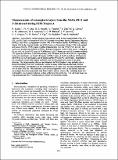Measurements of atmospheric layers from the NASA DC-8 and P-3B aircraft during PEM-Tropics A
Author(s)
Carroll, M. A.; Albercook, G. M.; Anderson, B. E.; Barrick, J. D. W.; Browell, E. V.; Gregory, G. L.; Sachse, G. W.; Vay, S.; Bradshaw, J. D.; Sandholm, S.; Stoller, Patrick C; Cho, J. Y. N.; Newell, R. E.; Thouret, V.; Zhu, Y.; ... Show more Show less
DownloadStolleretal-1999.pdf (1.891Mb)
PUBLISHER_POLICY
Publisher Policy
Article is made available in accordance with the publisher's policy and may be subject to US copyright law. Please refer to the publisher's site for terms of use.
Terms of use
Metadata
Show full item recordAbstract
Tropospheric vertical structure was analyzed using in situ measurements of O₃, CO, CH₄, and H₂O taken on board the NASA DC-8 aircraft during three Pacific Exploratory Missions (PEMs): PEM-West A, September-October 1991 in the western Pacific; PEM-West B, February-March 1994 in the western Pacific; and PEM-Tropics A, September-October 1996 in the central and eastern Pacific. PEM-Tropics A added measurements from the NASA P3-B aircraft. We used a new mode-based method to define a background against which to find layers. Using only O₃ and H₂O, we found 472 layers in PEM-Tropics A (0.72 layers per vertical kilometer profiled), 237 layers in PEM-West A (0.54 layers/km), and 158 layers in PEM-West B (0.41 layers/km). Using all constituents, we found 187 layers in PEM-Tropics A (0.43 layers/km), 128 layers in PEM-West A (0.29 layers/km), and 80 layers in PEM-West B (0.21 layers/km). Stratospheric air, sometimes mixed with trapped pollution, was the dominant layer source in all three missions. The larger number of layers per kilometer in PEM-Tropics A was probably due to repeated profiling of several “superlayers” visible in many of the mission lidar and potential voracity profiles. The thickness of the superlayers was of order 1 km, and the horizontal extent was of order 1000 km. We found that layers have an important effect on the thermal structure. An example based on ozonesonde data from Tahiti is shown, where a dry, subsiding layer was stabilized by much greater radiative cooling at the base than at the top. The stabilized layer can trap pollution and force vertical plumes to spread into horizontal layers.
Date issued
1999-03Department
Massachusetts Institute of Technology. Department of Earth, Atmospheric, and Planetary SciencesJournal
Journal of Geophysical Research: Atmospheres
Publisher
American Geophysical Union (AGU)
Citation
Stoller, P. et al. “Measurements of Atmospheric Layers from the NASA DC-8 and P-3B Aircraft During PEM-Tropics A.” Journal of Geophysical Research: Atmospheres 104, D5 (March 1999): 5745–5764 ©1999 American Geophysical Union
Version: Final published version
ISSN
2169-8996
2169-897X